It looked like the Timbers were well on their way to a 1-0 win over a bunkered in FC Cincinnati side Tuesday evening when, out of nowhere, goalkeeper Steve Clark made things interesting…
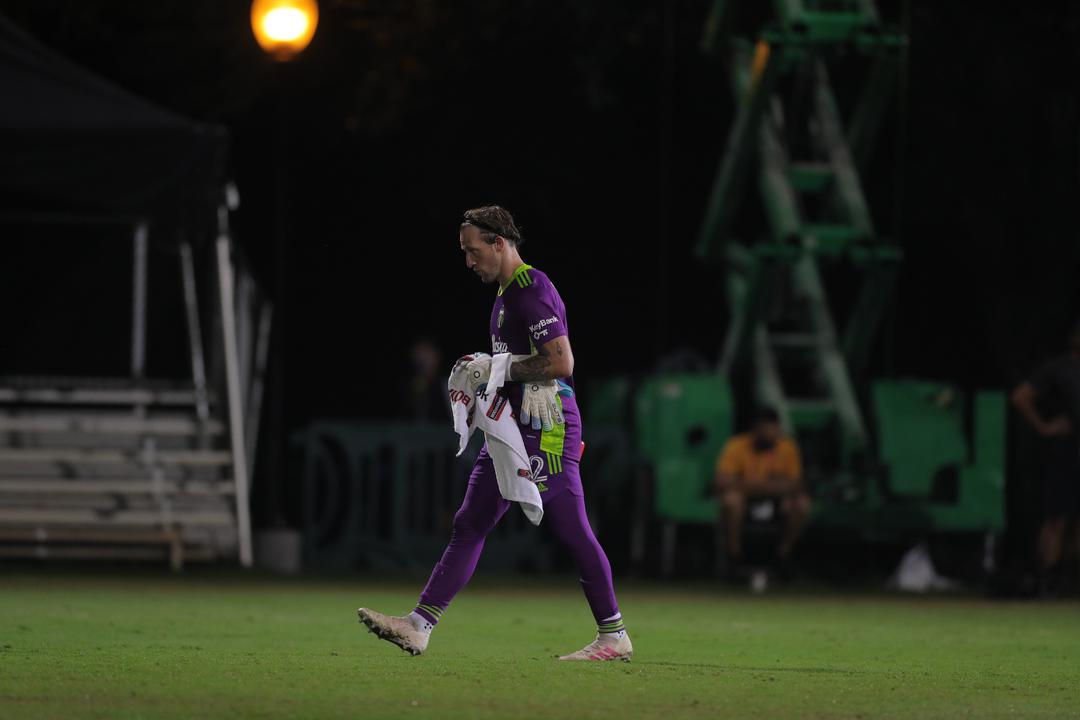

It looked like the Timbers were well on their way to a 1-0 win over a bunkered in FC Cincinnati side Tuesday evening when, out of nowhere, goalkeeper Steve Clark made things interesting…
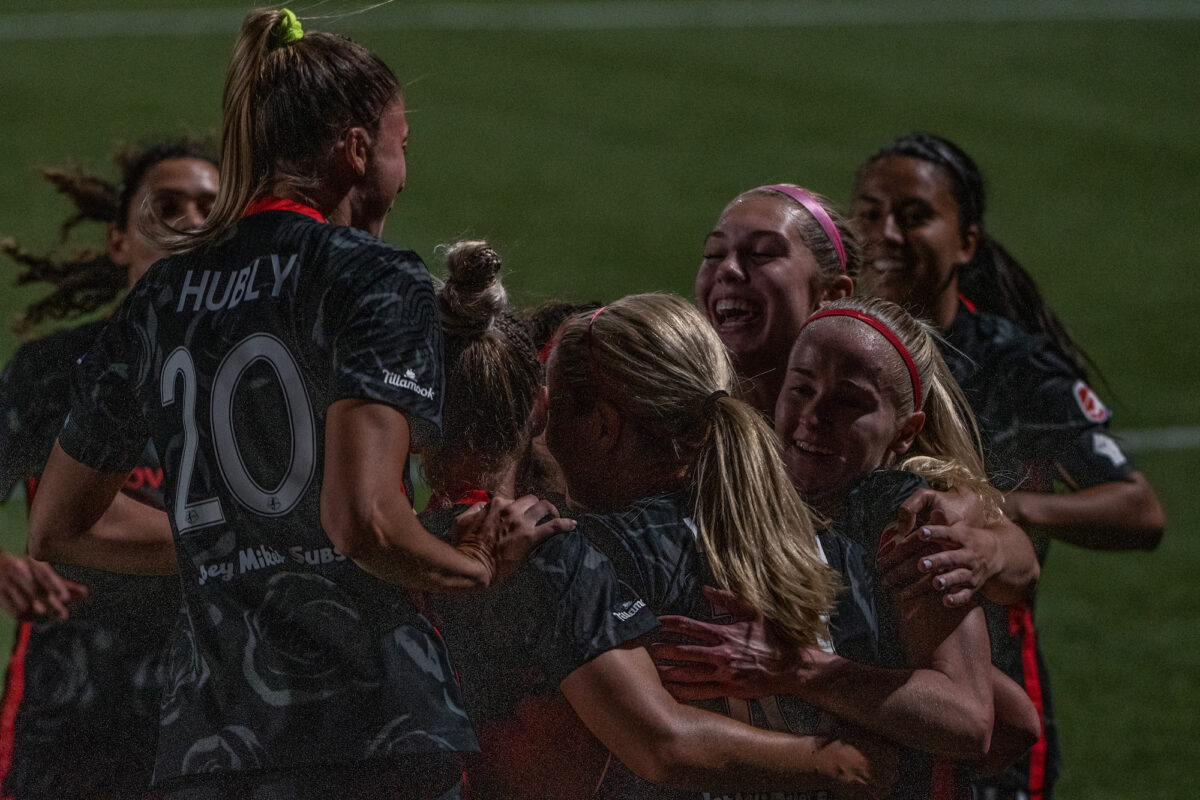
The soccer has come and gone for the Thorns, and for the rest of us, all that’s left to do is stare into the abyss and hope everything else might get slightly less bad at some point.
But first, let’s reflect on some of the big-picture takeaways from Portland’s Challenge Cup experience.
No summary of Portland’s Challenge Cup experience would be complete without noting the single overarching theme of the whole tournament, for all the teams involved, which is that the whole thing was very exhausting. The Thorns started the tournament without AD Franch and Sophia Smith, immediately lost Becky Sauerbrunn, and hung on to Lindsey Horan until she sat down in a defeated-looking heap ten minutes after the half in the quarterfinal. I do not know how Raquel Rodríguez or the 37-year-old Christine Sinclair were still ambulatory by the end of the tournament.
More striking than the impact on any particular player, though, was how fatigue shaped outcomes for Portland twice: first when they took down a North Carolina team that had started basically the same lineup throughout the preliminary round, and again when they limped out of that game and into their semifinal against Houston. Keeping up with even a tired Courage side is an extraordinary athletic feat, and the Thorns paid for it.
Portland played a new formation in this tournament, a 4-4-2 diamond. This made sense for the players they had available: with Tobin Heath sitting out and Midge Purce and Hayley Raso long gone, the Thorns were left with no real wide attacking threats. They did, however, have an excess of quality central midfielders of various shapes and sizes: Horan and Sinclair, of course, plus Rodríguez, Angela Salem, Celeste Boureille, Gabby Seiler, and Emily Ogle.
What was striking about this particular diamond was where the width came from—namely, in large part, from Rodríguez and Horan. In the team’s first outing against North Carolina, that was largely visible as both of them provided defensive muscle out wide, putting early pressure on runs by Jaelene Daniels or Lynn Williams to ease some of the burden off Portland’s outside backs.
That system is an interesting interpretation of what’s usually thought of as quite a narrow formation, and it went a long way toward containing the Courage; what looked weirder was when Horan and Rodríguez attacked from wide areas. The intent here seems to be to keep Sinclair (mostly) central and have her connect play both into the box and to whoever’s out wide, whether that’s Horan, Rodríguez, or one of the forwards. The problem is that lacking both players like Heath or Raso, who can stretch defenses out of shape and beat wide defenders one on one, and a reliable target striker, teams were able to focus their pressure on Sinclair and force her into sideways passes. What the Thorns were left with was a lot of very hopeful crosses and no one to put on the end of them.
Of course, attacking from out wide paid off one very important time, when Rodríguez sent a pass under Denise O’Sullivan to Morgan Weaver, who bodied past her mark to score the go-ahead goal. This is to say the system kind of worked. You could see how it was supposed to work in that moment. But they just couldn’t generate enough chances this way. Weaver, who looks extremely promising but still raw, can’t reliably beat defenders at this level; more important, it’s not the best use of Horan, Rodríguez, or especially Sinclair, who looked stranded a lot of the time.
In short, this was an interesting experiment while it lasted, and it helped the team find some notable success against North Carolina, but it would be hard to justify for a Thorns roster that included Heath, Sophia Smith, and one or more Rumored International Forwards.
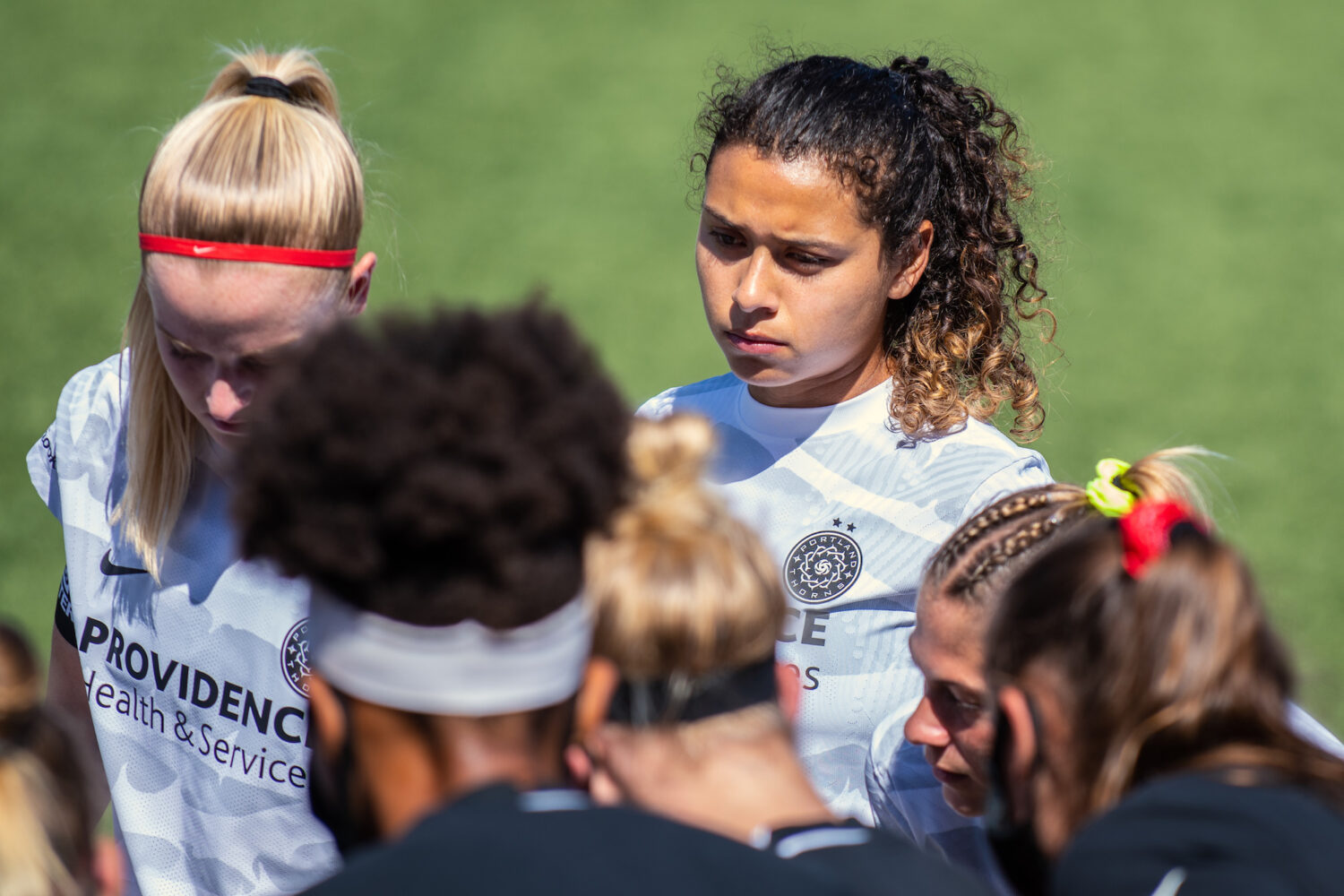
The pandemic has meant that the Thorns, like several other NWSL teams, never got the chance to finish building their roster—after having purged half of last year’s starting lineup, no less. Kadidiatou Diani, rumored to be headed to Portland for $445,000 a year, would (assuming she could have adapted to the physicality and competitiveness of the NWSL) have provided exactly the kind of creativity out wide the Thorns are currently lacking. Making matters worse, Ellie Carpenter, another key piece both defensively and going forward—and once thought to be the only Aussie who would survive the exodus—left shortly before the tournament.
On the other hand, the players Portland did acquire are all excellent additions. Rodríguez, arguably the most important piece, is the midfield partner to Horan—a second box-to-box player with the right combination of creativity, work rate, and defensive grit—that Parsons has been looking for since the 2017 season ended. Weaver is physically strong enough to body defenders and gutsy enough to take them on the dribble; with a little more experience under her belt, she looks like she could turn into the mythical goal-scoring forward Portland has lacked for years.
But the team made the most progress on the defensive side. Surprisingly for a team that picked up Becky Sauerbrunn in the offseason, that progress doesn’t just boil down to new signings. Christen Westphal was excellent, but the revelation this tournament was Kelli Hubly, who impressed at right back in the opener, then stepped up to fill the vacancy left by the injured Sauerbrunn centrally. She saved the Thorns more than once, and her willingness to step to opposing forwards made her a great partner for the more conservative Emily Menges. Finally, sitting deep in midfield, the team has an absolute bulldog in Salem, who’s been sidelined by injury for a good chunk of her time with the Thorns. All in all, the roster still looks incomplete, but it’s deeper than it looked heading into the tournament.
If you ask anyone on the team, they’ll likely say their biggest achievement this month was a return to the Thorns’ vaunted team culture, something both the players and Parsons say had slipped by the end of 2019. For all the talent on any given Thorns roster, this is an attitude-first coaching staff, and whether or not players have a certain personality and work ethic often guides both who gets signed and who gets traded away.
Parsons’ focus on building a team-first, relentlessly hard-working culture, and the unexpected results it sometimes produces, is underappreciated—at least outside Portland. This is a team that often excels when the odds are stacked against them, as they did during the World Cup last year, or during the Olympics in 2016. Even when they won the championship in 2017, they were using a (different) formation they had adopted to make up for Heath’s absence earlier that season, and they gritted and ground and, frankly, punched their way past the top team in the league.
They couldn’t figure out how to win that way this time around; the basic concept was a little too makeshift and the bench a little too shallow as the tournament wore on and injuries took out player after player. But if a strong team culture is the foundational variable Parsons and his players say it is, this is a significant step in the right direction.
The state of the culture is basically something we have to take the team’s word for, especially at a moment when no one is allowed to even speak to them in person. But that, plus an organized defense, have been the foundation for Portland’s success in the past, and if they stay focused on those two things, they’re in good shape looking toward 2021.
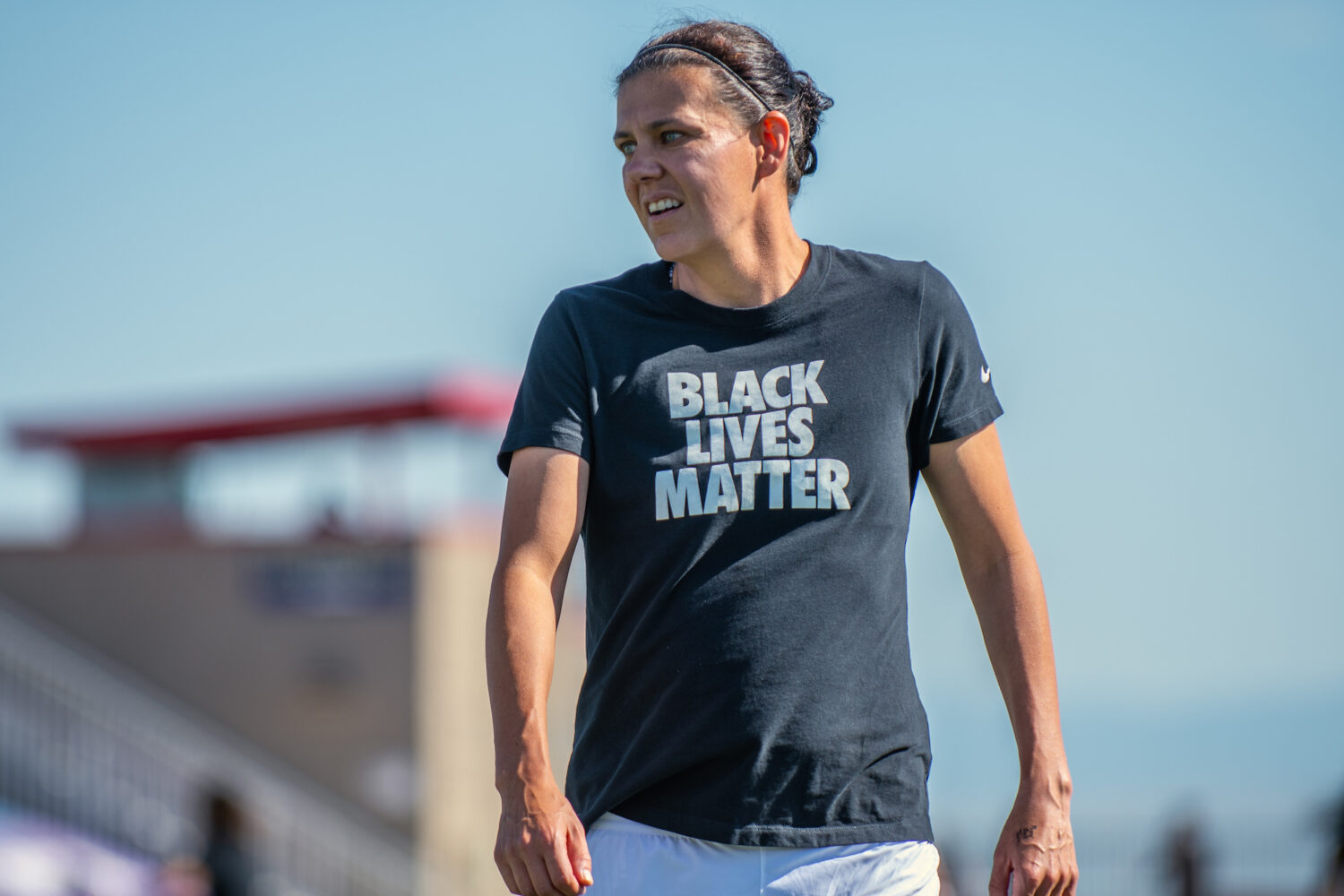
That’s the good news. The other news is that a wholesale rebuild is still looming for the Thorns, probably sooner rather than later. They have to expect to take some losses with two expansion teams entering, and then, on some unknown date, comes the real inevitable truth: Christine Sinclair cannot play professional soccer forever. It’s said that mileage matters more than years, so this truncated “season” may wind up extending her career, but she’s nonetheless nearing 40.
At that point, it’s anyone’s guess what direction this team goes in. They’ve built their midfield around Sinclair and Horan for the last five years, and one thing that became clear in Utah is that while Sinclair is still quality, she also needs certain types of players around her to succeed. When she departs, the club changes completely, the way things do when realities so long-lasting they feel like laws of physics change. The only certainty seems to be that the Thorns become, fully, Horan’s club. Beyond that? We’ll have to wait and see.
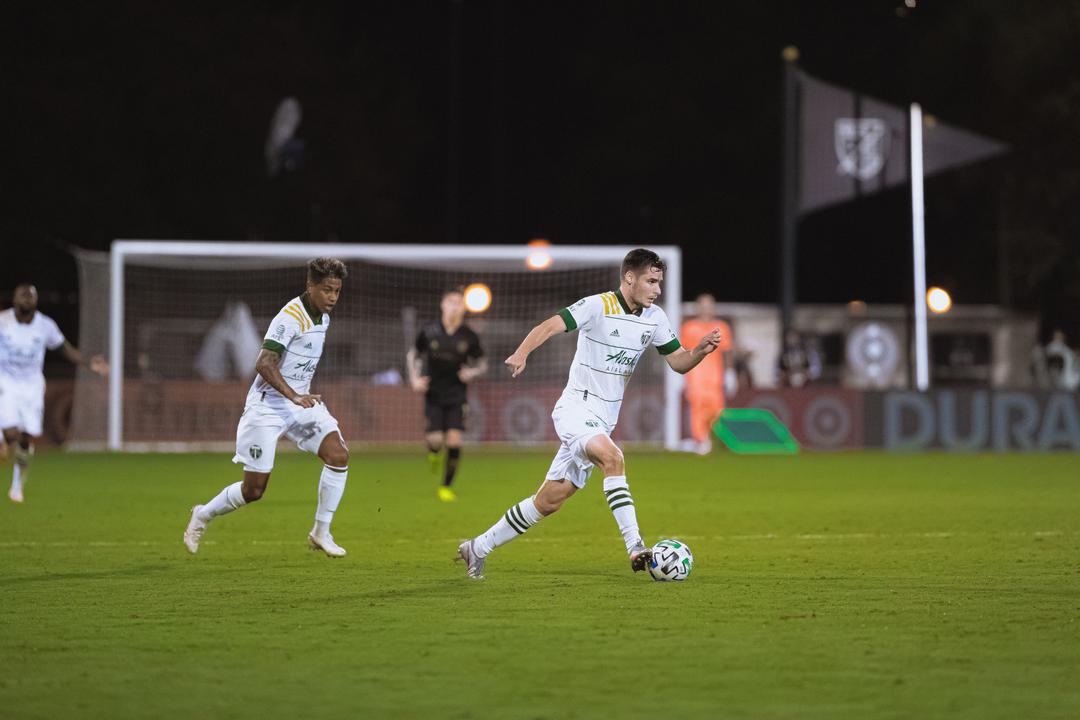
Match after match, the Portland Timbers continue to impress.
Two games in, and it seems as if there’s something new and more creative to take away from each game—something that we did not see back in March.
Against the Los Angeles Galaxy, we saw an increased sense of confidence throughout the team that manifested itself through the team’s combination play and intricate movement. In its game against Houston, we saw a team both creating and exploiting space all around the field, playing long balls with a purpose to unlock the Dynamo defense while shutting down one of Major League Soccer’s most potent attacks.
Portland did it again on Thursday night, coming in with a disciplined and compact defensive shape that managed to contain what is usually a LAFC buzzsaw to win Group F.
I don’t have much to say to open this column other than just to mention how impressive this Portland team has been over three games. The shape that the Timbers played last night required a lot of discipline (which I will go into later). I mentioned on Twitter than containing LAFC for 90 minutes is a Herculean effort––both the Dynamo and Galaxy learned that over the past week––and Portland looked defensively solid for more than 75 percent of the game. I guess what I am saying is that the Timbers look primed to make a run in this tournament and that my outlook on the team is a lot brighter than what it was when I left Providence Park back in March.
And … I guess I should mention that I had to put my bonfire-building supplies away late into the match. It’s time for the Timbers to get revenge for what was an embarrassing defeat a season ago.
The Timbers got out to a dream start against LAFC, striking first in the seventh minute.
Taking advantage of LAFC’s aggression, Portland found success in testing the opposing backline early and often. Thanks to ESPN’s aerial cam, it’s easy to see what went into Niezgoda’s opening goal, the Pole’s first as a Timber.
During this transitional moment, Portland creates a mini-overload on the right side of the field. During this, Niezgoda is sitting between the right center back and right back, waiting to pounce. The overload pulls Tristan Blackmon towards the sideline while Latif Blessing, the right back, is caught cheating a little too far up the field. This leaves Niezgoda with yards of space to run into, and he makes the finish look easy.
Conceding first is not a new trend for Bob Bradley’s men: They did it against both the Houston Dynamo and LA Galaxy. This may be looked back upon as an easy finish, but the goal proved vital for the Timbers, allowing them to weather 15 minutes of LAFC brilliance and come away with a point at the end of the game.
Yes, Bradley Wright-Phillips is not the same lethal player that carried the New York Red Bulls on his shoulders for what seems like a decade, but he is still one of the most dangerous strikers in MLS—and he proved it yet again on Thursday night.
This goal comes down to movement. Wright-Phillips sees the right side of defense pushed high and immediately makes a looping run to find that space while losing his defender, Bill Tuiloma, in the process.
Thanks to the space that his movement created, when Wright-Phillips receives the ball, he has a few touches to settle it before firing it past Clark. This is a clinical, outside-the-box finish from the Englishman, proving that age is just a number.
In his post-game media availability, head coach, Giovanni Savarese, mentioned the tired legs that his team was playing with near the end of the first half. That can easily be seen in the second goal the Timbers gave up in the course of four minutes.
Honestly, there is not too much to this goal. It’s just poor marking at the back post by Bill Tuiloma as Kaye gets by him with a quick spin move. Kudos to the Canadian for the good finish, because there’s nothing that Clark could really do there.
In a tournament with so many young players breaking out for their respective teams, Jeremy Ebobisse’s star may shine among the brightest.
For the third-consecutive game, Ebobisse found the back of the net for Portland, this time rising up and sending a towering header past Sisniega.
This is just pure grit from some of the Timbers tallest players. In a way, Tuiloma makes up for his role in the two LAFC goals as he finds the energy to rise up and win this ball in a crowded box. After a missed half-chance minutes earlier, Ebobisse makes no mistake this time as he powered the ball to the bottom right corner.
Ebobisse is making a name for himself so far this tournament. You have to think that US Men’s National Team coach, Gregg Berhalter, is watching every game in the bubble with a close eye and Ebobisse is commanding his attention.
One of my biggest takeaways from this match is the defense shape that the Timbers played in. It was a narrow 4-4-2, both horizontally and vertically, that allowed space out wide, but prevented any penetration from a LAFC lineup that knows how to exploit even a sliver of space. Playing with such a compact shape for 90 minutes against one of the league’s best sides requires insane amounts of focus and discipline. Give or take a few moments, the Timbers looked relatively drilled in this setup.
The 4-4-2 did its job for a majority of the game. As seen above, LAFC was content to pass it backwards and around the block. To exploit this system, the ball needs to be played quickly between the lines with a purpose. Because LAFC played more of a probing style early on in the game, players were able to step up and win balls in both defense and midfield. According to Opta, the Timbers made 40 CLEARANCES(!!!) over the course of the game compared to LAFC’s eight.
Below, I’m going to insert a couple of examples of what the Timbers want to do. It’s a lot of last-ditch tackling that happened time and time again throughout the game.
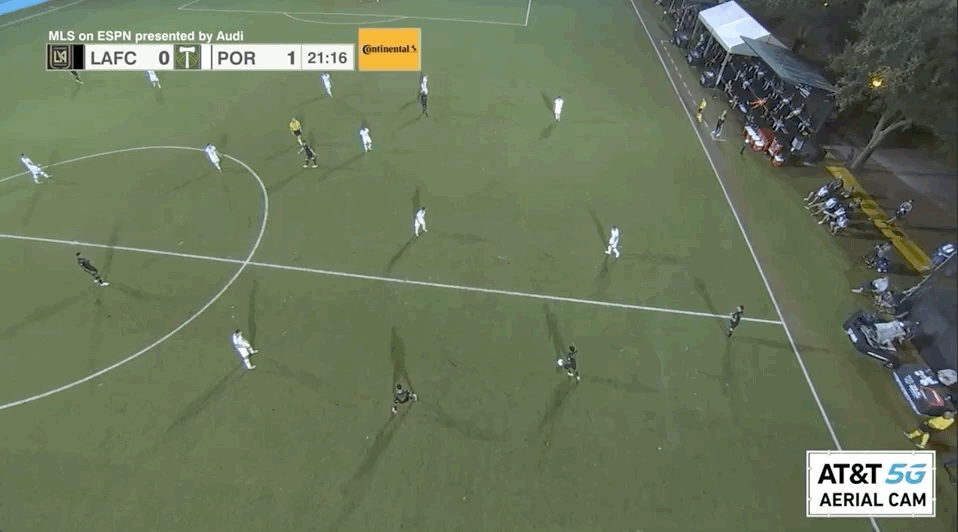
In this clip, the midfield does a good job of stepping up and preventing LAFC to get the ball in a dangerous, central area.
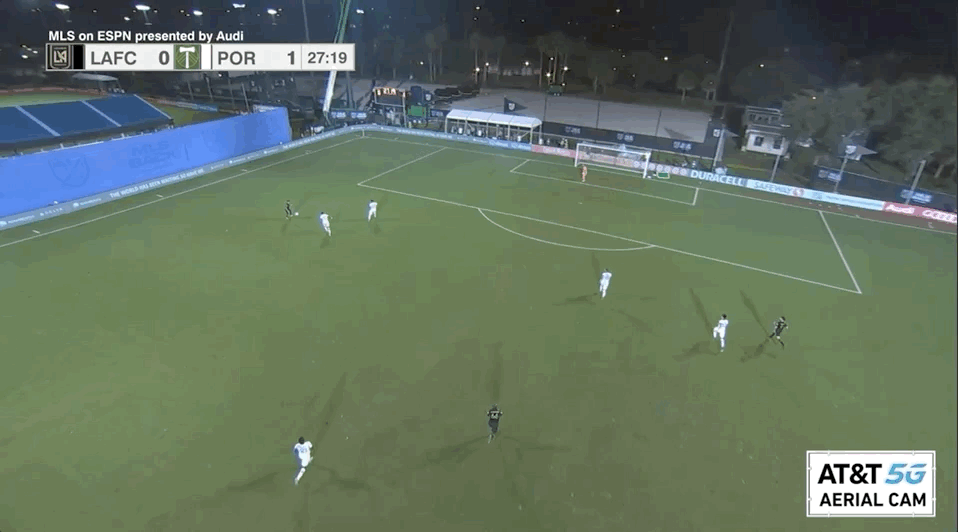
Here, the defense does a great job to cut this pass off as LAFC looks to make a direct pass towards the top of the box.
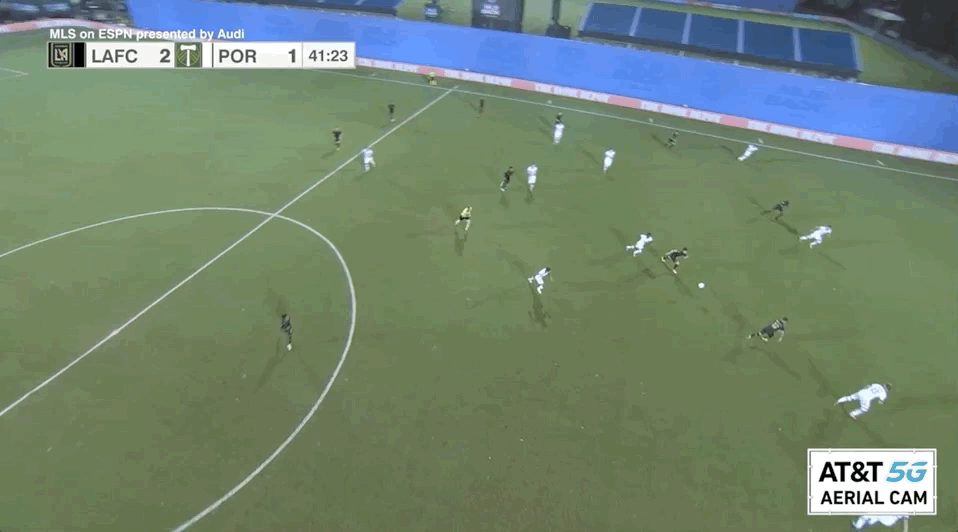
This third example is what happens when you have a defensive midfield of Diego Chará and Cristhian Paredes. Portland wanted to ensure that if LAFC tried to play centrally, they would be punished. And it worked.
There’s so much that I wanted to touch on when it comes to the defense side of the ball that I thought I should separate it into two different sections.
The defensive shape that Portland used was a very compact 4-4-2. How it defended was in a mid-block.
By playing this way, the Timbers invited LAFC to towards midfield before applying pressure. The goal of this is to create space in behind LAFC’s backline, and then take advantage of the aggression to create opportunities by running into this now-vacated area.
The Timbers were relatively successful early on but, from the 30th minute until halftime, players started to get tired, and they stopped playing into the space that they created after winning the ball. This allowed LAFC to implement a counter man-marking system, which continued to win the ball high up the field, effectively trapping Portland in its own half.
“I think what was difficult today was when we lost the ball so quickly,” Diego Chará said after the game. “When we recovered the ball, we tried to play forward, but we missed a lot of passes, and I think that made it more difficult for us to keep the ball.”
All of this is evident in the graphics below.
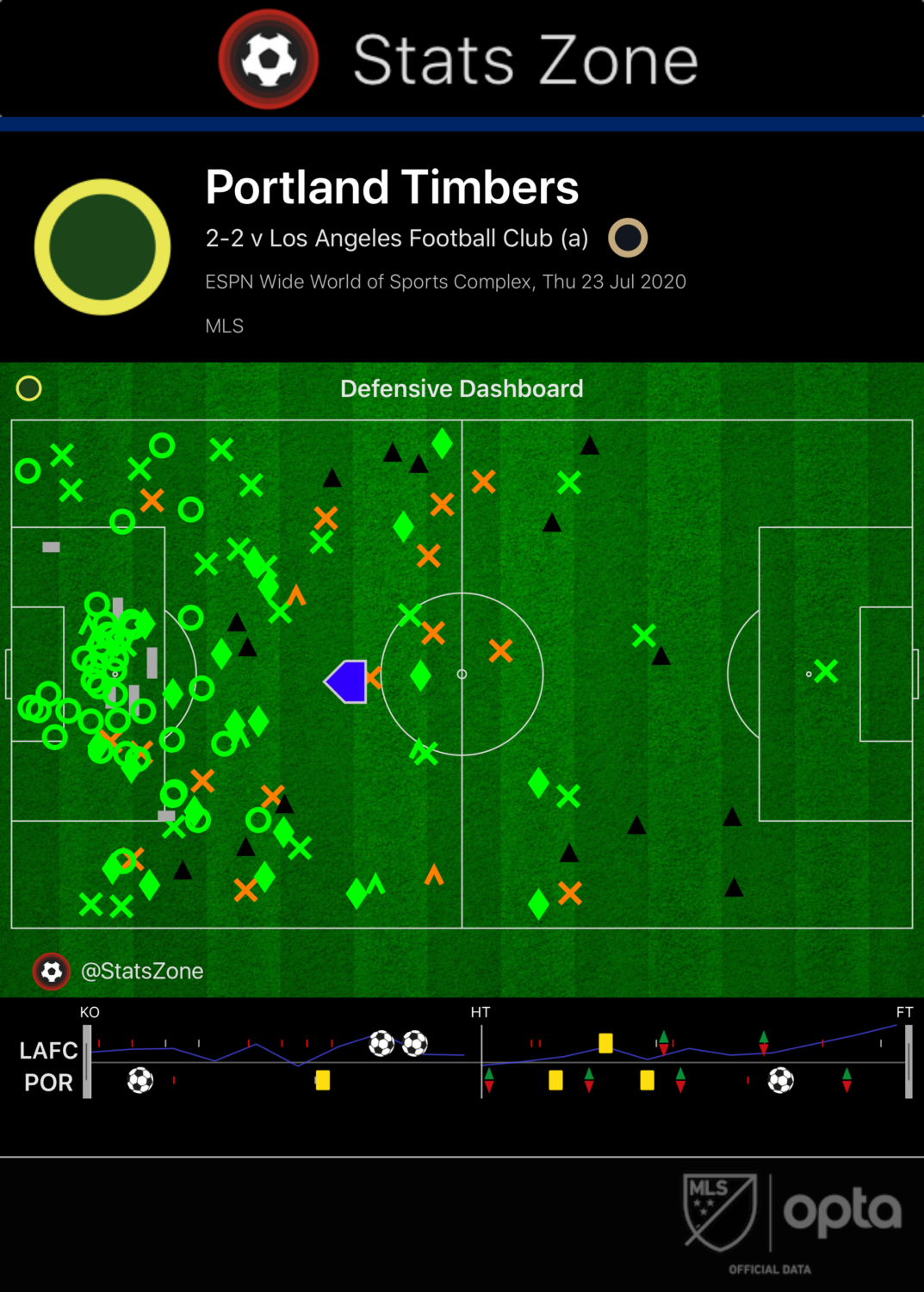
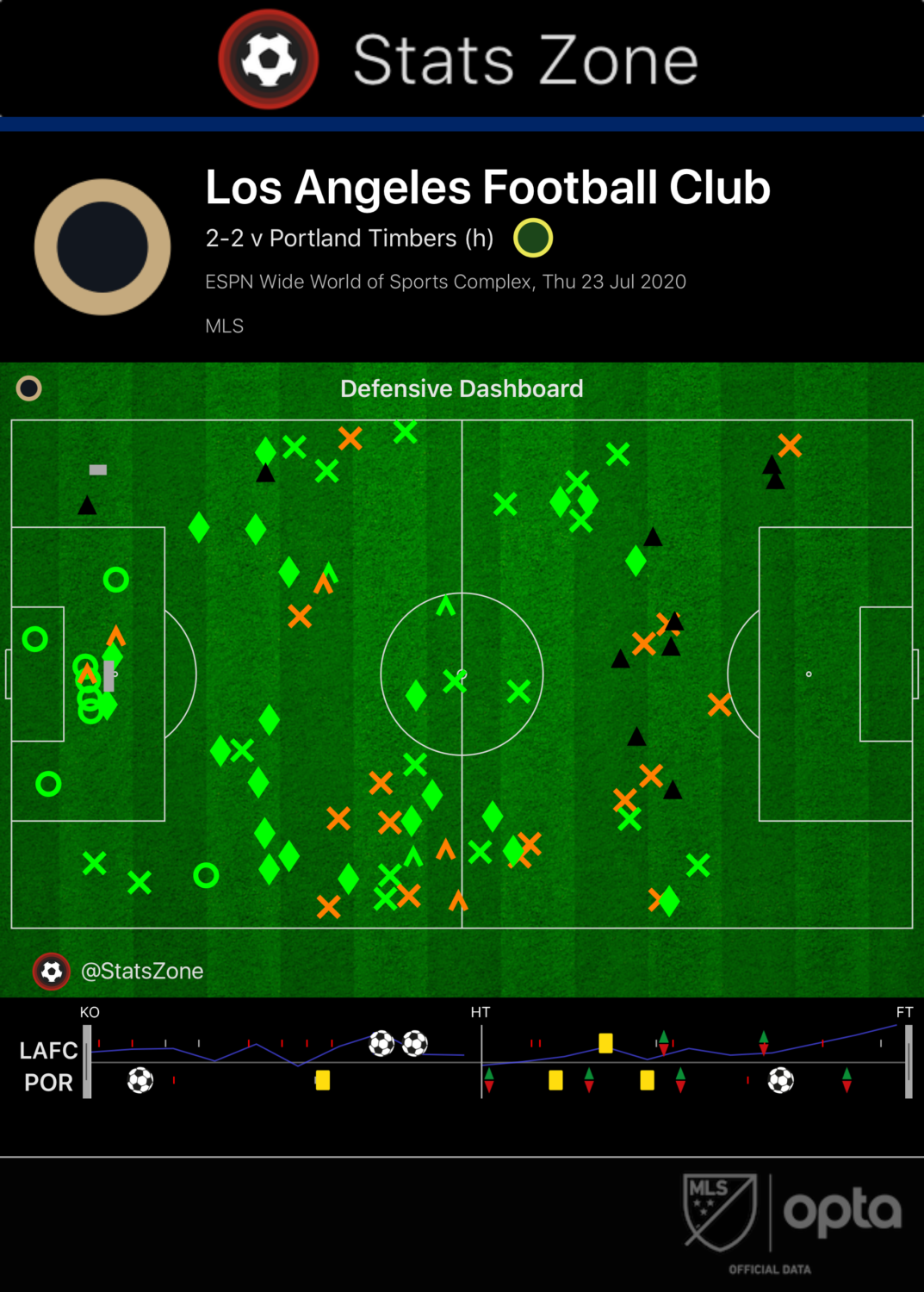
Look at where Portland defends versus where LAFC defends. Portland is playing a dangerous game of bend-but-don’t-break soccer, mostly in its own half, while LAFC is constantly trying to play on the front foot.
I can throw so many more graphics and stats such as the ones above in the article, but I don’t need to. The Timbers put on a defensive masterclass on Thursday night. Sure, it wasn’t perfect, but it’s the type of shape that every team that wants to make a deep run into a tournament needs. It’s important to remember that LAFC can exploit any defensive system and, if the Timbers could look like this defensively every game, they could go quite far in Orlando.
“The first thirty minutes we had the better of the play. We were very tight, and we didn’t allow them to be able to create much,” Savarese said when asked about LAFC’s dominant stretch. “In the last 15 minutes in the first half, they started to find the balls in between the lines; they started making better movements in those areas that we wanted to protect, and we were tired so we couldn’t close those spaces as well as we did the first thirty minutes.
“We also gave up the ball in those moments, different than the first thirty minutes when we had a lot of the ball and were smart in the way me moved it. I think that the two goals were two moments that are a little bit separated from them finding space. Yes, they had a little bit more of the ball in those minutes, they tried to create, but we defended very very well even though we had some players being tired.”
When a team presses as hard as LAFC does, the opponent usually has two options: A) Try to play through the pressure in hopes to find space to attack into; or B) Stop thinking for a few seconds and clear the ball, praying to find a teammate somewhere in the attack.
In the past, the Timbers would have taken option B, trying to recycle the ball wide and play it long, which often resulted in a quick loss of possession. But these are not the Timbers of old. Against LAFC, Portland invited the pressure and attempted to move up the field through multiple series of intricate passing and combination play. It did not always work, but when it did it was pretty.
Part of playing through a press is knowing when to commit numbers forward after winning the ball versus when to sit back. Whatever the decision is, every player needs to be on the same page to ensure that there are no gaps. Playing into the created space catches a team when they are most vulnerable at the back, but if you lose the ball, there is now plenty of vacated space for the opposing team to exploit.
Above is an example of what happens when a team gambles wrong. Remember the compact 4-4-2 block I pointed out above? This is what it looks like when caught in transition.
“It was a challenge trying to balance [attacking versus defending], understanding that we didn’t want to expose ourselves defensively, but also not wanting to sacrifice the potential for a counter-attack and getting in behind the space that they were leaving,” Jeremy Ebobisse said. “A fine line for attacking players, myself and the wingers, to balance, but ultimately I think that we had some good opportunities on the break.
“That shows a job well done to manage difficulties when they had the ball and were penetrating us and those times we were able to break out, complete a few passes, and unbalance them.”
As Ebobisse eluded to, this is a formula that teams have to get right every game. There were moments in which the Timbers were caught out, like shown above, but overall they put in a solid defensive shift and allowed their attacking talents to find a pair of goals on the other end of the field.
Now it’s onto the round of 16, where FC Cincinnati awaits. One of the surprise teams of the tournament so far, the onus will most likely be put on the Timbers to break down a compact Cincinnati side. If Portland can put together everything that they’ve shown from the group stage of this tournament, advancing to the final eight is a real possibility.
It’s time for revenge.
Video courtesy of ESPN aerial cam. Graphics courtesy of Opta and StatsZone.
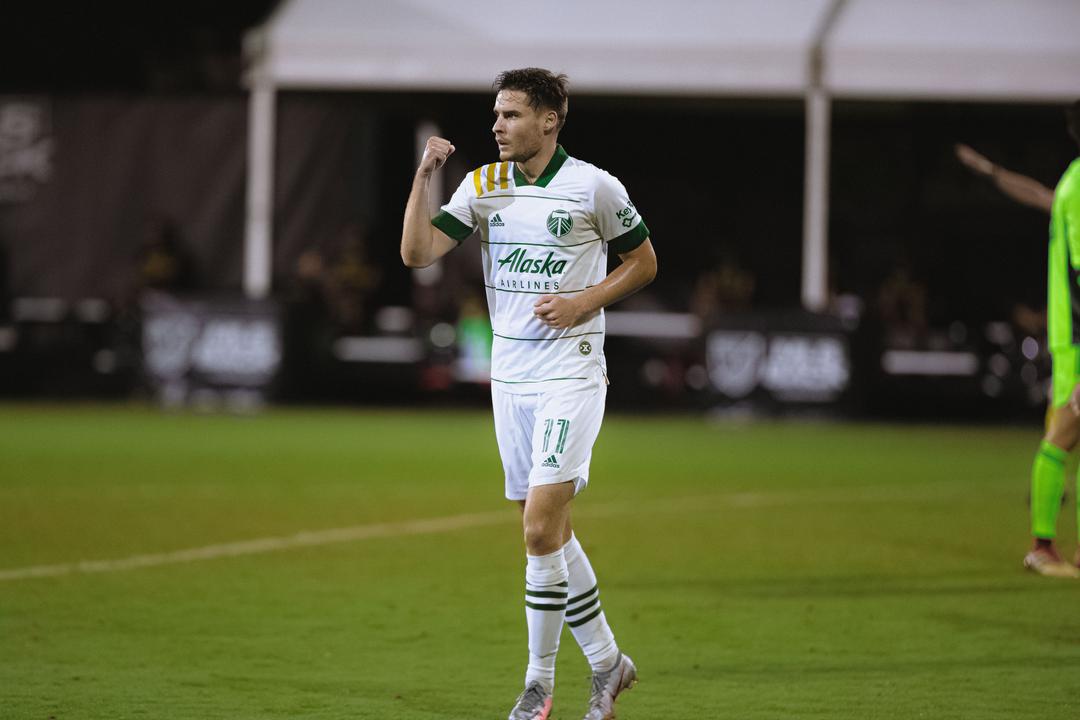
The Portland Timbers scored early and late in Thursday night’s 2-2 draw against Los Angeles FC, clinching the top spot in the Group F of the MLS is Back Tournament with the point over their recent rivals.
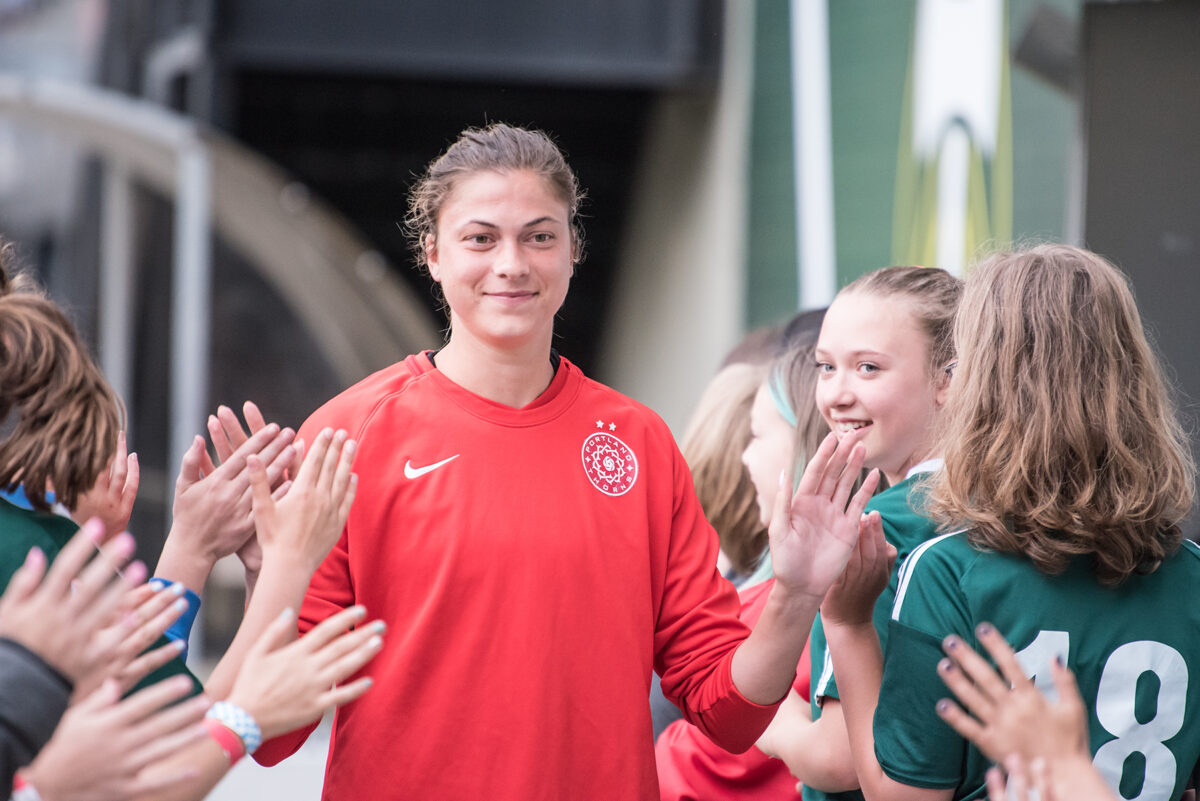
The Portland Thorns depart the NWSL Challenge Cup in the semifinals after losing 1–0 to the Houston Dash on a Rachel Daly header. The Thorns defense, excellent all tournament, could only be breached after Sophie Schmidt’s header hit the bar and left Britt Eckerstrom stranded.
Lindsey Horan was listed as an available sub but was dressed in street clothes on the bench. Horan recorded the second most minutes of the team through the opening stages (aside from Christine Sinclair, of course) and Celeste Boureille took her place.
After the game, Mark Parsons said that the team had left it all on the field against North Carolina to get the win, and they played their worst game of the tournament today. The Dash kept Portland under constant pressure in midfield that they couldn’t play their way out of, and despite how well the Thorns defended, they can’t have too many complaints about being sent home at this stage.
The Thorns stuck with the diamond this game, with Morgan Weaver and Simone Charley, their best available strike partnership, up top. With Boureille bogged down deep in midfield trying to handle Houston’s strikers dropping deep, those two had very little in the way of support, and were often tasked with chasing down balls over the top just to try to stretch play at all. Raquel Rodríguez had too much to do to offer much support either. In fact, the brightest attacking spark came from substitute Emily Ogle, who in her role as a deep playmaker provided some of the best service from deep the Thorns were able to manage all game.
That’s telling. The Thorns are a team that like to work their way into shooting opportunities on a second or third pass to maximize the expected goal average of any given attack, and get into the position to make those decisive passes with incisive running. Rodríguez, one of the Thorns’ best attacking players this tournament, couldn’t get forward to do what she does best, and the team was too slow to recognize that they needed more quality passing from deep to unlock the Dash.
On the other end, however, Kelli Hubly and Emily Menges were both excellent, with Menges making several decisive tackles to break up counterattacks, most memorably to stop a Nichelle Prince run where it looked like she would be in on goal.
Houston had plenty of attacks this game despite having a minimal amount of possession. They went on the break quickly whenever they forced a turnover. But despite all that, the Thorns restricted them to very few good chances. They just turned one of their two into a goal.
Crosses are always a low percentage attack. See Portland’s efforts late on in the opening stages of the tournament, and North Carolina’s efforts against Portland. They looked particularly pointless here, with Houston connecting on only two of fourteen crosses and Portland only three of twelve. In part, it’s down to timely defensive interventions in the middle of the park from the Thorns, but they also mostly just let Houston have that space. Of course, it doesn’t matter how inefficient a team’s attack is sometimes: all it takes is a moment of chaos for a team to score, and Houston produced more of those than Portland.
The Dash had many of the best attacks of the game, but couldn’t create many shooting opportunities. The Thorns had most of the possession, but couldn’t do anything with it. Just about the only effective play happening anywhere for most of the game was Houston’s midfield pressure. Rachel Daly and Nichelle Prince are two extremely active forwards: one or two would almost always be putting pressure on the Thorns backline while they were trying to play from deep, which meant that most of the Thorns possession in the game took place well away from goal.
Houston’s back line played very high to compress the space available to Thorns midfielders, and in that space, they were able to bring a ton of bodies in to break up any attempt by Salem or Boureille to play forward. Whenever Sinclair had the ball, they were quick to close her down. Ogle and Gabby Seiler came on in midfield after halftime and improved the situation by getting better passing from that area, but even though Weaver and Charley are fast, neither of them are really strikers that thrive on balls over the top. They like to play to their feet and attack their defender, and Houston didn’t let anyone on the Thorns have that.
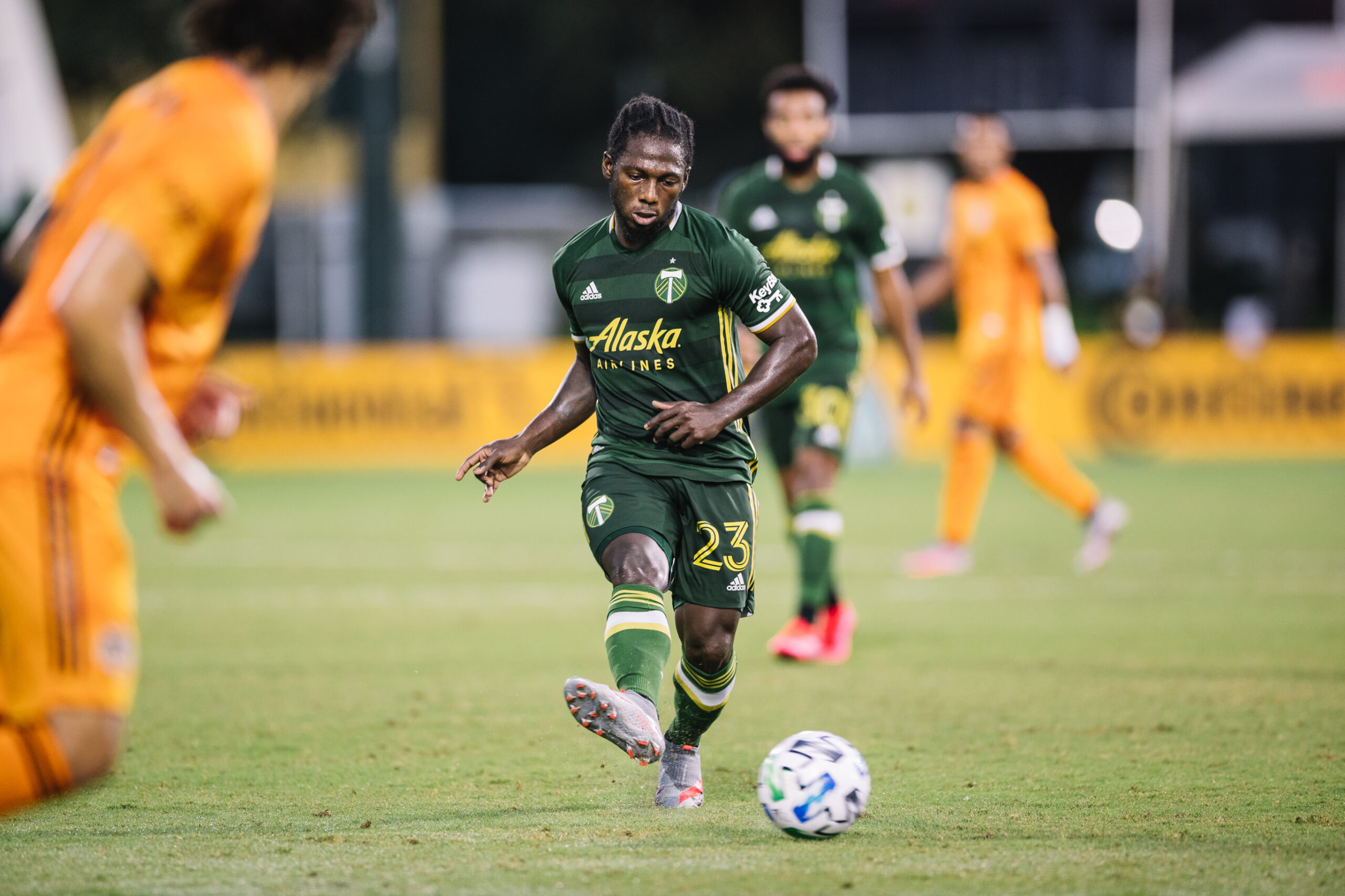
After a slow start to the 2020 Major League Soccer season, the Portland Timbers came to Orlando with something to prove. Although they’ve only played two games in the MLS is Back Tournament, it seems as if they are starting to do just that.
With a pair of 2-1 victories, the Portland Timbers are one of just four teams to take all six points from their first two games. Against the Los Angeles Galaxy, Portland came out sharp and played with a sense of confidence and precision that eluded them against Minnesota United and Nashville SC. They continued that against the Houston Dynamo, playing between lines and controlling possession against one of the most dangerous attacks in MLS.
Through strong and inspired play, the Timbers have guaranteed themselves a spot in the knockout rounds with a game to spare. But just because they know they will advance doesn’t mean they are taking the next game off or will be complacent—at least not with a game against LAFC looming.
“I think there is too much at stake [to be complacent],” head coach Giovanni Savarese told reporters via a Tuesday morning Zoom conference. “First, we want to come away with three points and finish first in the group. We’re not looking at who we’re playing after, that is why the mentality is very strong. We know that it is going to be a competitive match, and they’ve always been competitive games every time that we play LAFC.”
As Savarese mentioned, these two teams have a history in knockout competitions. In the two seasons since LAFC joined MLS, each team has knocked the other out of the US Open Cup in exciting, albeit at times contentious, games. Despite sitting on only four points after two games, an easy argument can be made that LAFC, even sans 2019 league MVP Carlos Vela, is the strongest team in this tournament.
“We have seen in the last two matches that [LAFC] have been challenged,” Savarese said. “I think this is a group that wants to prove to everyone that it is no longer dependent on Vela because many have said that, so maybe that’s one part of LAFC at the moment. We expect a very competitive match, we know that they are very difficult to play against, and we will bring a very good challenge to them like we always have.”
There is Eduard Atuesta and Latif Blessing creating havoc in midfield. Savarese explicitly pointed out the importance of limiting one-on-one opportunities from dynamic wingers Brian Rodríguez and Diego Rossi. At striker, there’s always-potent Bradley Wright-Phillips.
All of this talent available to head coach Bob Bradley is enough to give opposing coaches migraines. Staying focused for all 90 minutes is vital, but it is easier said than done against a team like LAFC.
“I think a major adjustment we need to have is finishing games a little bit stronger,” Eryk Williamson said. “We were up 2-0 both games and conceding late isn’t ideal, but it’s a clear focus point now and knowing us, LAFC’s strength is turning it on late in halves, and I think it’s something where we have to make sure that we are locked in for the 90-plus minutes.
“If we can disrupt them in any way possible and just continue to play our game with the fluidity we have up top and all the interchange to make it really difficult for them to get going.”
In all likelihood, whichever side controls the midfield will most likely win the game. Over its past two contests, Portland has made connecting play through midfield a priority. Managing the midfield means controlling possession, giving LAFC less time on the ball to pick out passes and easily dissect the Timbers’ shape. Emphasizing quick combination play also helps the Timbers create some one-on-one opportunities of their own.
“The combinations that we have practiced have been key,” Yimmi Chará said through a translator. “It is something that we have improved a lot, it’s something that we have been training on for a long time, and taking advantage of that space our opponent gives us. Up until now, it’s been one of the team’s strengths. Now, Gio Savarese wants us spatially to take advantage of those last few feet on the field so we can always take advantage of the one-on-one and come ahead.”
Another benefit of controlling midfield is that it helps shield Portland’s backline, allowing them to focus on defending deeper areas and to not be as concerned about leaving space if they have to help contain Rodríguez and Rossi out wide. If the Timbers can find some success in the midfield, they could prevent counter-attacking opportunities, limit the space LAFC desires, and control the ever-important balance between sending numbers forward in attack versus staying back.
“I know LAFC has a strong midfield and that we want to be known as one of the top midfields in the league,” Williamson said. “I think this is a good test for us as midfielders to win the midfield battle, but not only that, continue to help our backline defend Rossi and Rodríguez. It’s just a very good task for us and we’re excited for the challenge.”
According to Savarese, the Timbers will be playing with a full-strength lineup come Thursday night. He’s reported no injuries to the media, and despite fielding two full-strength lineups over the past week, he doesn’t plan to heavily rotate the lineup in anticipation for the knockout rounds.
Savarese anticipates that Bradley will play his strongest lineup, and once again emphasized the team’s collective goal of taking all three points and winning the group.
Thursday’s game projects to be one of the Timbers’ toughest challenges this season. As the press conference neared its end, Savarese put everything in perspective. The repeating message to the team has been to not take anything for granted, because just two months ago players were locked in their homes. Now, they prepare to take on last seasons Supporters’ Shield winners for the top spot in Group F.
“We enjoy being here, we’re excited to compete, we’re happy to be in a tournament,” Savarese said. “We missed this game when we were at home and now every game for us is a final.”
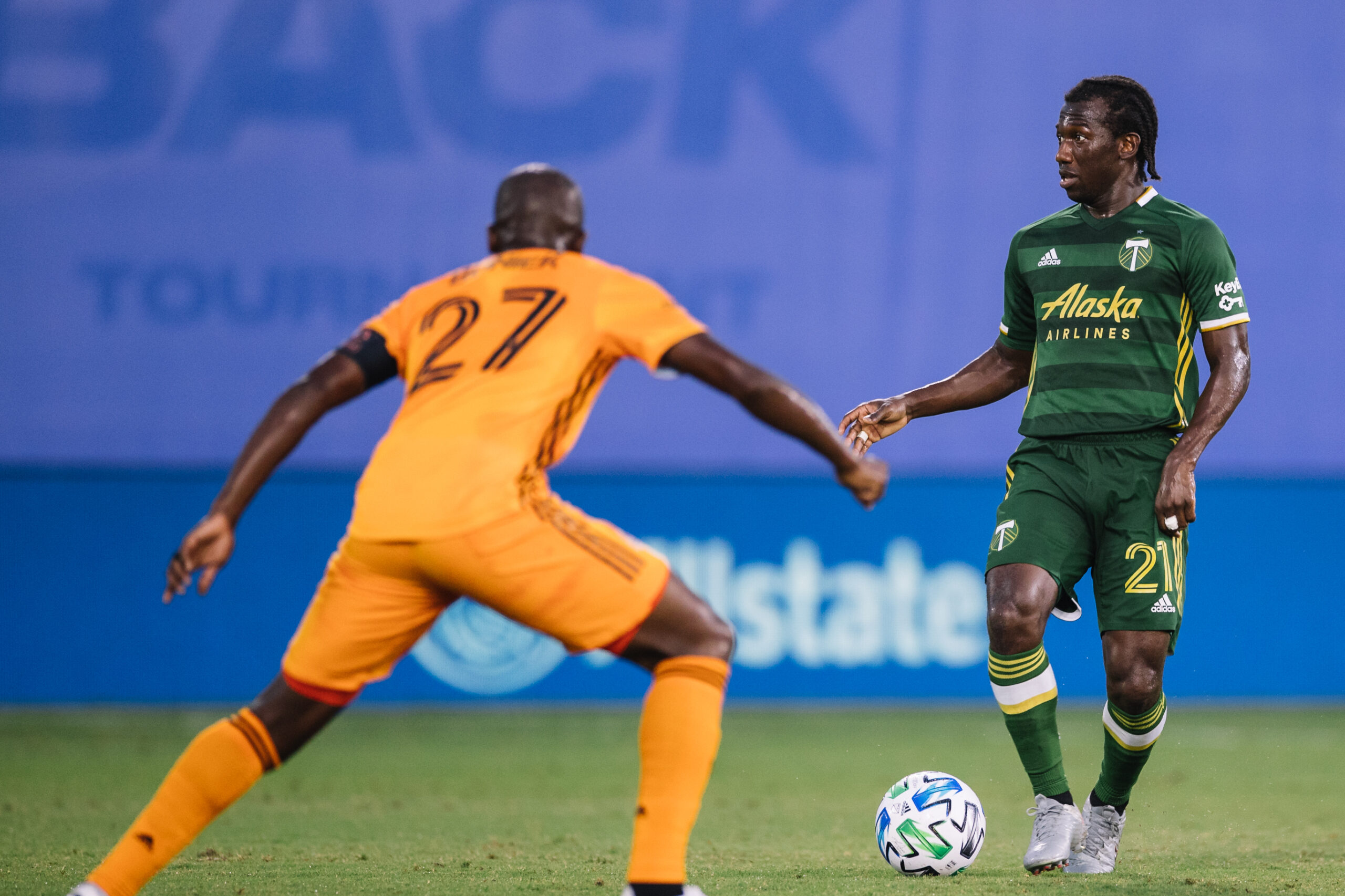
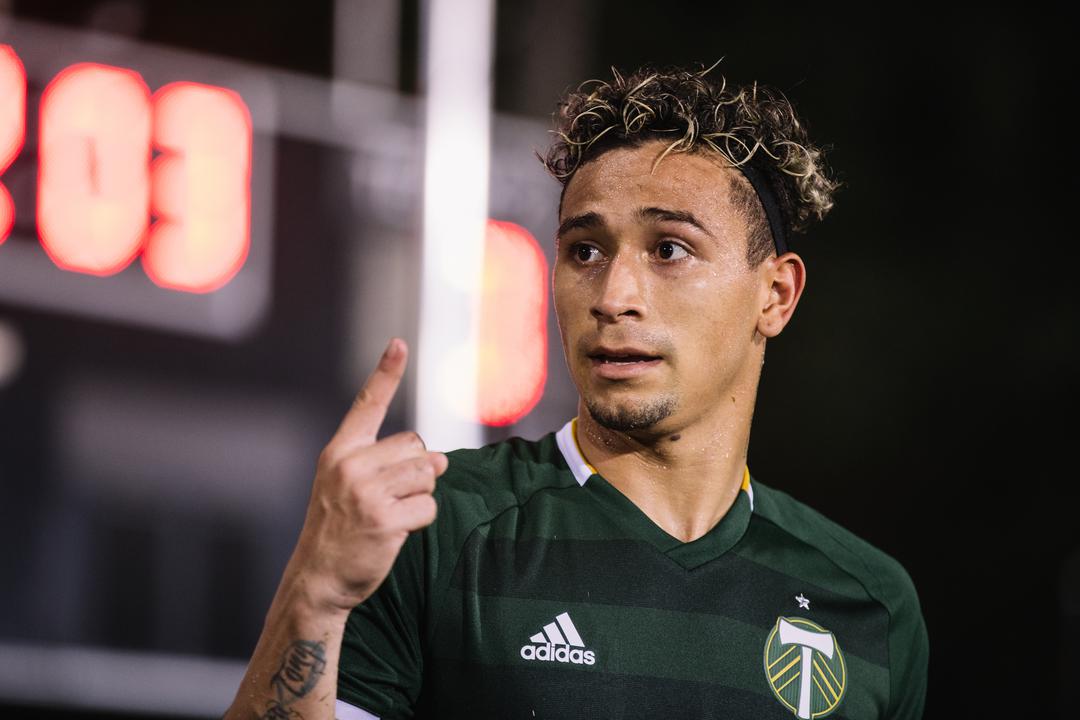
In a battle between two teams looking to outlast their opponent, wear them down, and catch them off balance, the Portland Timbers were the team still standing after 90 grueling minutes against the Houston Dynamo on Saturday night. In their second game of the MLS is Back Tournament group stage, the Timbers looked in control for most of the match as they fought their way to a 2-1 victory.
Although the Dynamo went down a man in the final minutes of the match after Alberth Elis picked up his second yellow card of the night, it was the Timbers’ ability to take their chances that played a deciding role in the match. Inch-perfect finishes from Jeremy Ebobisse in the 35th minute and Diego Valeri in the 61st minute put the Timbers up 2-0, giving the side the breathing room needed to see out the match.
Before his sending off, Elis did manage to pull one back for the Dynamo, earning a penalty kick in the 86th minute after putting a header off the hand of Jorge Villafana — who had an otherwise excellent game — and then stepping up to convert the spot-kick past Steve Clark to pull the Dynamo back within one with minutes left in the match.
In the heat and humidity of the Orlando summer, a major factor in the match against the Dynamo seemed to be the fresh legs of the Timbers’ substitutes.
Giovanni Savarese went to his bench early on Saturday, bringing on Andy Polo for Yimmi Chara in the 60th minute. He then made two more subs in the 69th minute, bringing on Marvin Loria and Jaroslaw Niezgoda for Eryk Williamson and Jeremy Ebobisse. Finally, Savarese capped off the night by bringing on Chris Duvall for Pablo Bonilla in the 82nd minute after the youngster absorbed his third hard foul of the night.
The Dynamo, on the other hand, made one sub in the 62nd minute, one in the 87th, and two in the 88th.
As a result of Savarese’s aggressive use of subs, the Timbers looked markedly fresher than their opponents during the second half even after having played with a man down for a big chunk of last Friday’s win over the LA Galaxy. With the Dynamo flagging, the Timbers subs were able to make a real impact on the match, quickly breaking up Dynamo attempts to get forward and winning the fifty-fifty balls that might otherwise have given Houston a chance to get back in the game.
Despite being subbed off late in the match, Saturday was a successful first-team debut for Bonilla who got the start over Chris Duvall at right-back, being granted the privilege of matching up against the Dynamo’s vaunted attacking trio: Alberth Elis, Darwin Quintero, and Mauro Manotas. Bonilla, a Venezuelan youth international signed from T2 exactly one month ago, was introduced to the MLS life by the Dynamo when in just the 7th minute he took a cleat to the thigh from Houston midfielder Maynor Figueroa.
Despite the rough treatment by the opposition, Bonilla acquitted himself well in the first half, providing solid coverage down the right flank and acting as an outlet for Yimmi Chara on his regular runs forward. In the second half the youngster continued his strong outing, getting further forward down the pitch as well as providing several clutch tackles when the Dynamo got forward on the Timbers’ right.
Most interesting was Bonilla’s play with Marvin Loria after the Costa Rican 23-year-old came on as a substitute early in the second half. After spending the pre-suspension preseason together with T2, Bonilla and Loria had clear chemistry playing together on the wing and combined for a strong chance on goal that Loria ultimately had blocked by a defender as he got his shot away.
The win against the Dynamo guarantees that the Timbers will reach the knockout rounds of the MLSIBT and leaves the Timbers with a final group match against LAFC next Thursday that will at most affect the Timbers’ seed coming out of the group stage.
How the Timbers treat this match will tell us much about how they view this tournament and how they view the possibility of playing out the remainder of the season. These group stage games count as part of the 2020 MLS regular season, so it will be interesting to see if the Timbers view this last group stage match as a chance to get minutes to players that have mostly served as subs like Niezgoda or Andy Polo, to bring in some youngsters like Blake Bodily or Marco Farfan who have yet to see the pitch, or just another game to run out the regular starting XI, tournament be damned.
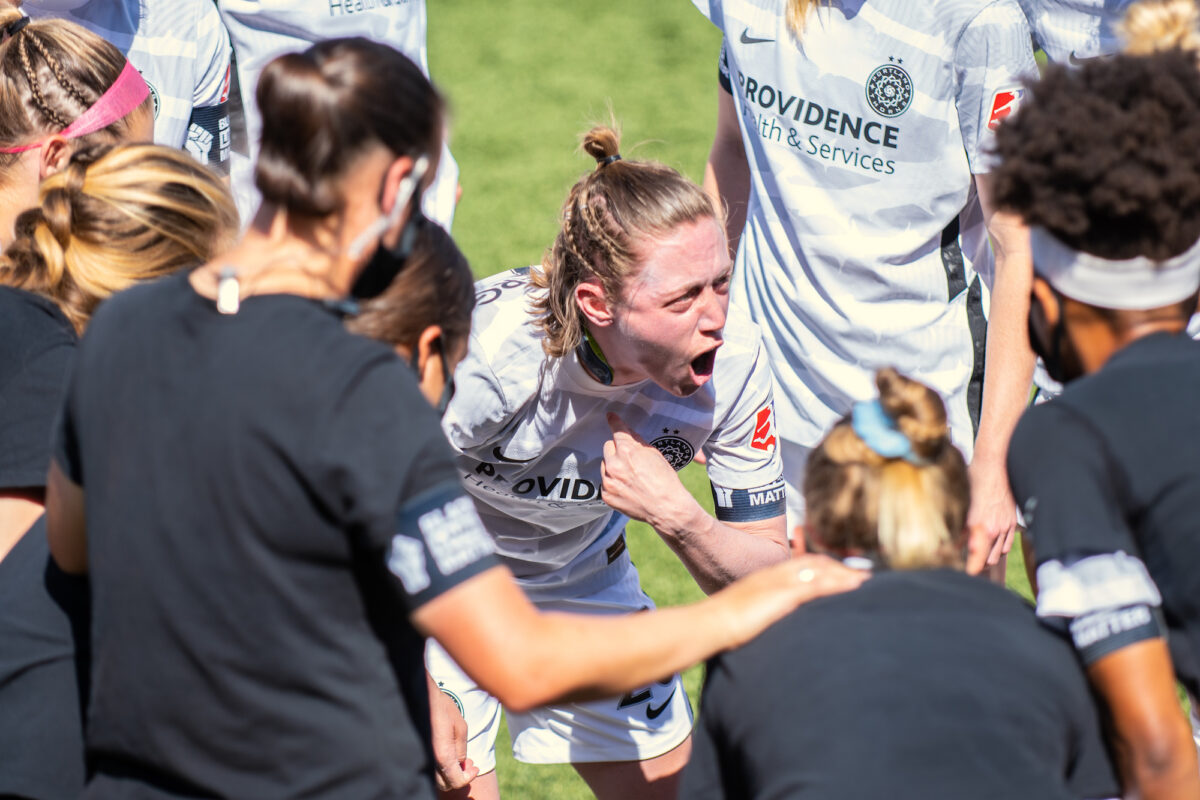
After wrapping up the preliminary round of the Challenge Cup winless in last place, the Portland Thorns pulled out a thrilling 1–0 win over the North Carolina Courage with a 68th-minute goal from rookie Morgan Weaver.
The match marks the first playoff game that the Courage have lost since the 2017 NWSL Final, and the first time North Carolina has been shut out since last May.
Beyond the tournament-ending injuries for AD Franch, Becky Sauerbrunn, and Sophia Smith, Bella Bixby, Lindsey Horan, and Emily Menges were also listed as questionable ahead of today’s match. While both Horan and Menges started the game, Bixby’s right knee injury paved the way for Britt Eckerstrom’s first start since August of last year.
Unfortunately, the knocks didn’t end there. The first half of the match saw both Horan and Katherine Reynolds go down—for Reynolds, in a head collision with Lynn Williams that saw both of them bleeding and Reynolds subbed off the pitch.
Horan was able to come out in the second half, but fell to the ground again in Portland’s defensive box. She was subbed out for Celeste Boureille in the 51st minute.
Especially given the fact that the Thorns have looked uninspired without Horan in this tournament, these early injuries were worrying.
Portland started the game with Reynolds on the right, Meghan Klingenberg on the left, and an Emily Menges-Kelli Hubly centerback pairing. In her 40 minutes on the field, Reynolds was often left dealing with Williams up North Carolina’s left flank, and found herself burned by Williams a handful of times—including in the first minute of the match.
While Reynolds is a better defender when isolated one on one, the decision to start her over the faster Christen Westphal was questionable, and the Thorns were lucky that the Courage didn’t take advantage by overloading that side with Williams and Jaelene Daniels.
The other somewhat illogical choice, in the first 20 minutes at least, was the partnership between Menges and Hubly. At the beginning of the match, Menges was consistently the player stepping higher to win the ball while Hubly hung back, something that felt counterproductive given their respective strengths. However, the duo figured things out as the match went on, with Hubly more often pushing up to win the ball and Menges stepping to take on players.
After scoring a total of two goals in the preliminary rounds—with one of those goals coming off a Horan set-piece header—things didn’t look particularly promising for Portland’s attack heading into this one. On top of that, they’ve looked significantly worse without Horan.
Regardless, the Thorns broke through when Christen Westphal played a pass up the line Rocky Rodríguez. Rodríguez dribbled to the endline and squared her hips to send a low cross front of goal and beat her defender. Morgan Weaver peeled off Addisyn Merrick at the far post to tap the ball in, and the Thorns were up with their first game-winner of the tournament.
Go on and shine, Rook ✨
Morgan Weaver gives @ThornsFC the lead!
0-1 | #NCvPOR
Tune in now on @CBSAllAccess and @Twitch.#NWSLChallengeCup pic.twitter.com/pFSBk0XrKk
— National Women’s Soccer League (@NWSL) July 17, 2020
Slipping down Portland’s goalkeeper depth chart to the third string, it was hard to know what to expect from Eckerstrom going into this game. Fortunately, she did really, really well.
If she had any nerves, Eckerstrom worked through them in the first half; her handling was a bit shaky, and she was lucky to catch her own rebound on two separate occasions. She was also fortunate in the fact that North Carolina struggled to put their shots on target, with a handful of sitters hit wide of goal or missed completely.
However, the Thorns ended the half 0–0, and Eckerstrom showed flashes of the fantastic positioning and ability off her line that she relied on heavily in the second part of the game.
And that second half was something to behold; Eckerstrom was everywhere across the face of goal. She came out several times to smother a through-ball in traffic—including blocking a Courage breakaway and deflecting the rebound wide—and got a strong punch to a brilliant Debinha free kick to preserve the Thorns’ lead.
.@Breck28 take a bow 🙌
An absolute incredible save by the @ThornsFC goalkeeper for the @Verizon Save of the Match.#NWSLChallengeCup pic.twitter.com/8lyM7tG9HF
— National Women’s Soccer League (@NWSL) July 17, 2020
Eckerstrom was absolutely fantastic today, but it was kind of cool to see Nadine Angerer listed as a sub for the Thorns—even if it was the result of Portland’s first- and second-string keepers being injured. And, yeah, it was a great game, but can you honestly say it wouldn’t have been better if Angerer had gotten a couple minutes at the end?

Was a non-roster invitee for the Thorns ahead of 2017. Never appeared for Portland, but ended up playing ten games in Norway that same year. According to Soccerway, is now affiliated with a second-tier club in Sweden (joined by a teammate of the name Emilie Brandt).
Stuck around for two seasons as Portland’s third-string keeper in the pre-Bella Bixby days. Was called up as an amateur player for a bit in 2016—presenting us with the never-realized possibility of having an Emily in goal behind an Emily center back pairing—but didn’t get to take the field for the Thorns. Allegedly went to Cal, claimed the number 19 jersey in Portland, and is a Scorpio, but otherwise her identity is something of a mystery.
The Thorns’ longest-tenured center back. Drafted out of Georgetown in the third round in 2014, making her arguably the best value ever to emerge from the NWSL College Draft. Had a legendary block against Jess McDonald late in the 2017 championship. Coined the phrase “let’s make a constellation.”
The wildest ball of lightning to ever pull on a Thorns jersey. The number one overall pick in the 2016 draft. Incredible one moment, inexplicable the next, and an absolute content machine, on and off the field. The inaugural NWSL Most Online Player; hexed by Amy Rodriguez late in the 2019 season.
Made four appearances for the Thorns in 2013 after starting as a trialist. A 2004 Stanford graduate who stepped away from the game before joining the Bay Area Breeze of the now-defunct USL W-League. The rest is lost to history.
The legendary poet out of Mount Holyoke Female Seminary. Refused to play if the Thorns weren’t in their white kits. After a playoff loss in the 1861 season, she was asked a generic question about the emotions in the locker room, and replied:
Success is counted sweetest
By those who ne’er succeed.
To comprehend a nectar
Requires sorest need.
Not one of all the purple Host
Who took the Flag today
Can tell the definition
So clear of victory
As he defeated – dying –
On whose forbidden ear
The distant strains of triumph
Burst agonized and clear!
Selected 24th overall as Portland’s only pick in the 2019 NWSL College Draft, the clear result of a need to maintain a plurality of Emilies in anticipation of losing Sonnett. Still young, usually strong on the ball, yet to be defined.
Unlike her sister Charlotte, a prolific goalscorer for England and the Chicago Red Stars, Brönte was a hard-working No. 6—a real shit-kicker of a midfielder. Some have called her a limited player, but what she did—namely, a calculated professional foul to stop a developing attack in its tracks—she did well. Both feared and respected by opposing midfields.
Portland’s first Martian-born player. A discovery player acquired in 2132 after she failed to impress for Paris Saint-Germain and had been playing in the Moon League, a gimmicky non-FIFA-sanctioned competition played on a giant field with goals that hovered several dozen feet off the ground. A manager who believed in her and a more constructive training environment did wonders, and she went on to score a team-leading 21 goals in 32 games in her first season.
Joined the Thorns midway through the 2024 season after completing a psychology degree at the University of Minnesota. Was fourth all-time in Gophers goals scored (38) and tied for seventh with assists (25), despite playing fullback for most of her sophomore year. Effective as a No. 9, but thrives as a Hayley Raso-esque wide forward.
After waiting decades for an effective goal-scoring center forward to materialize, the 2079 Thorns decided to take advantage of the league’s new roster rule expanding the number of android player slots. The prototype, 3M1-LX, had played in preseason several seasons earlier but tended to have finishing problems; even when the service from Lindsey Horan 2 (a clone of her namesake) was perfect, it tended to sky the ball over the net. Training its ball trajectory algorithm on several billion additional data points didn’t work. Oddly, the turning point came when it was fed a dataset of human knock-knock jokes—all it needed, it seems, was to feel like part of the team.